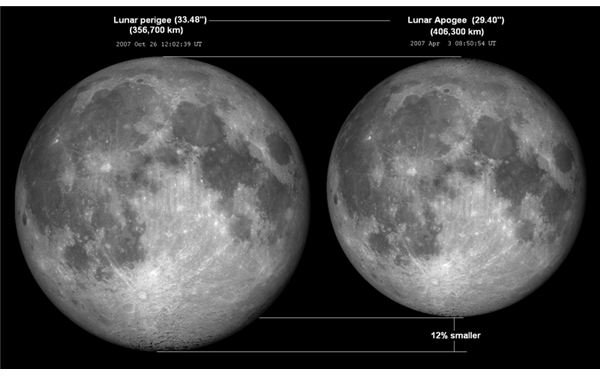What is Meant By Apogee and Perigee - Definitions and Details
Orbits and Ellipses
The majority of celestial bodies and satellites that revolve around objects in the Solar System follow non-circular orbits. Their orbital path is usually an ellipse with the planet not being in the exact center of the orbital pattern, but at one of the two foci_._ In order to describe these paths in greater detail, scientists have determined specific points on them, such as the apogee and the perigee. However, in order to explain what is meant by apogee and perigee, it is necessary to define some general terms first.
Definitions and Properties
The apoapsis or apocenter
is the furthest point from one of the foci of an elliptical orbit. On the contrary, the closest point to the same focus is called periapsis or _pericente_r. The general term that describes either of these points is called apsis. In the case that the Earth is located at one of the two foci of the elliptical orbit, the closest point is called perigee and the furthest point is called apogee (see image description).
What is more important is that the behavior of a body or satellite changes during apogee or perigee. When the satellite reaches the furthest point from the Earth, the potential energy is at its maximum, while the kinetic energy and the velocity of the satellite are at their minimum. The opposite phenomenon occurs when the satellite reaches the nearest point to the Earth. The potential energy is minimum and the kinetic energy is maximum. Since the orbital speed varies along the elliptical path, satellites move faster at perigee and slower at apogee.
Apogee and perigee are Earth-specific terms, and other terms exist for different celestial bodies. For example, when the Sun is at the center of the orbit, the furthest point is called aphelion and the nearest, perihelion.
Image: According to the image above, point 1 corresponds to the apogee and point 2 corresponds to the perigee of the orbit. Point 3 represents the Earth that is located at one of the two foci of the elliptical orbit.
How the Moon Changes During its Orbital Path

When the Moon, the Earth’s satellite, passes from apogee to perigee, certain changes occur regarding its size, brightness and position. The distance of the Moon slightly changes as it passes from these points, making the mean distance 384,401 km. During the years 1750 and 2125, the closest perigee was at a distance of 356,375 km on 4th of January 1912, and the furthest apogee of the Moon will be 406,720 km away on the 3rd of February 2125.
Size
Although the difference in the Moon’s size cannot be directly observed, it is quite significant. The image shows the relative size difference when the Moon passes from these points.
Brightness
A full Moon near perigee is a lot brighter than a full Moon near apogee. As a matter of fact, the Moon may shine 30% or 1.3 times brighter at perigee and this amount is also due to the logarithmic response of the human eye as far as light is concerned. The relative differences in brightness and size are difficult to observe because there is no absolute reference to compare them with.
Position of Features
Another significant change during apogee and perigee is a slight alteration in the position of features on the Moon disc. Although we are familiar with the concept that the Moon always shows the same side toward the Earth, we can in fact observe 59% of the Moon’s surface. This is due to the eccentricity and the inclination of the Moon’s orbit around the Earth. During the course of its orbit, the Moon appears to nod up, down, left and right, or rotate around Mare Crisium, the dark circle near the upper right limb of the Moon.
Click here to see an animation of how the Moon changes when it passes from these points.
Tides: The Main Lunar Effect on Earth
The effect of the Moon’s gravitational pull on Earth varies during apogee and perigee. When the Moon is at the furthest distance from the Earth, its gravitational pull is minimum. The most prominent result of this weak gravitational pull is the low tides. On the other hand, when the Moon is at the nearest point—perigee, the gravitational pull is maximum and the tides reach their highest level. This phenomenon is very important, primarily to the marine and coastal ecosystems. Human marine activities, navigation, fishing, surfing, swimming etc. are also affected, since they are closely connected to and sometimes depend on this phenomenon.
Sources:
- _“Apogee and Perigee of the Moon”:_https://www.moonconnection.com/apogee_perigee.phtml
- Inconstant Moon: https://www.fourmilab.ch/earthview/moon_ap_per.html
- universetoday.com: https://www.universetoday.com/33823/apogee
Images:
- Apogee and Perigee by Pearson Scott Foresman
- Moon Apogee and Perigee by Tomruen
